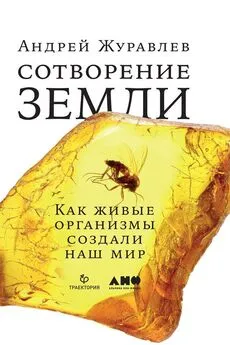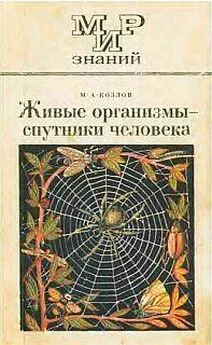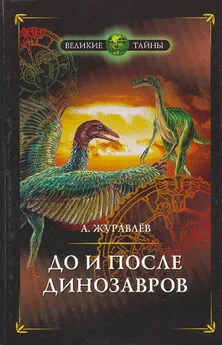Андрей Журавлёв - Сотворение Земли. Как живые организмы создали наш мир
- Название:Сотворение Земли. Как живые организмы создали наш мир
- Автор:
- Жанр:
- Издательство:Альпина нон-фикшн
- Год:2018
- Город:Москва
- ISBN:978-5-9614-5294-5
- Рейтинг:
- Избранное:Добавить в избранное
-
Отзывы:
-
Ваша оценка:
Андрей Журавлёв - Сотворение Земли. Как живые организмы создали наш мир краткое содержание
О том, как формировалась наша планета — такая, какой мы ее знаем, — книга Андрея Журавлева, палеонтолога, доктора биологических наук, профессора кафедры биологической эволюции биологического факультета МГУ.
Сотворение Земли. Как живые организмы создали наш мир - читать онлайн бесплатно ознакомительный отрывок
Интервал:
Закладка:
Ивахненко М. Ф. Тетраподы Восточно-Европейского плакката — позднепалеозойского территориально-природного комплекса. — М.: Наука, 2001. (Тр. ПИН РАН. Т. 283).
Мейен С. В. Основы палеоботаники. Справочное пособие. — М.: Недра, 1987.
Мейен С. В. Листья на камне: Размышления о палеоботанике, геологии, эволюции и путях познания живого. — М.: ГЕОС, 2001. (Тр. ГИН РАН. Науч. — поп. сер., вып. 1).
Шмальгаузен И. И. Происхождение наземных позвоночных. — М.: Наука, 1964.
Ahlberg P. E., Clack J. A., Lukševičs E., Blom H., Zupiņš I. 2008. Ventastega curonica and the origin of tetrapod morphology // Nature , 453, 1199–1204.
Algeo T. J., Marenco P. J., Saltzman M. R. 2016. Co-evolution of oceans, climate, and the biosphere during the ‘Ordovician Revolution’: A review // Palaeogeography, Palaeoclimatology, Palaeoecology, 458, 1–11.
Anderson P. S. L., Friedman M., Ruta M. 2013. Late to the table: Diversification of tetrapod mandibular biomechanics lagged behind the evolution of terrestriality // Integrative and Comparative Biology, 53, 197–208.
Beerling D. J. et al. 1998. The influence of Carboniferous palaeoatmosphere on plant function: an experimental and modelling assessment // Philosophical Transactions of the Royal Society of London B: Biological Sciences, 353, 131–40.
Beerling D. J., Berner R. A. 2004. Feedback and the coevolution of plants and atmospheric CO 2// Proceedings of the National Academy of Sciences of the USA, 102, 1302–5.
Berner R. A. et al. 2000. Isotope fractionation and atmospheric oxygen: Implications for Phanerozoic O 2evolution // Science, 287, 1630–3.
Berry J. A., Beerling D. J., Franks P. J. 2010. Stomata: key players in the Earth system, past and present // Current Opinion in Plant Biology , 13, 233–40.
Bonneville S. et al. 2009. Plant-driven fungal weathering: Early stages of mineral alteration at the nanometer scale // Geology , 37, 615–8.
Boyce C. K. et al. 2003. Chemical evidence for cell wall lignification and the evolution of tracheids in Early Devonian plants // International Journal of Plant Sciences , 164, 691–702.
Boyce C. K. et al. 2007. Devonian landscape heterogeneity recorded by a giant fungus // Geology , 35, 399–402.
Braudrick C. A., Dietrich W. E., Leverich G. T., Sklar L. S. 2009. Experimental evidence for the conditions necessary to sustain meandering in coarse-bedded rivers // Proceedings of the National Academy of Sciences of the USA, 106, 16936–41.
Canoville A., Chinsamy A. 2017. Bone microstructure of pareiasaurs (Parareptilia) from the Karoo Basin, South Africa: Implications for growth strategies and lifestyle habits // The Anatomical Record , 300, 1039–66.
Clack J. A. 2007. Devonian climate change, breathing, and the origin of tetrapod stem group // Integrative and Comparative Biology , 47, 510–23.
Clement A. M., Long J. A. 2010. Air-breathing adaptation in a marine Devonian lungfish // Biology Letters , 6, 509–12.
Coates M. I., Ruta M., Friedman M. 2008. Ever since Owen: Changing perspectives on the early evolution of tetrapods // Annual Review of Ecology, Evolution, and Systematics , 39, 571–92.
Davies N. S., Gibling M. R. 2010. Cambrian to Devonian evolution of alluvial systems: The sedimentological impact of the earliest land plants // Earth-Science Reviews, 98, 171–200.
DiMichele W. A., Phillips T. L. 1994. Paleobotanical and paleoecological constraints on models of peat formation in the Late Carboniferous of Euramerica // Palaeogeography, Palaeoclimatology, Palaeoecology, 106, 39–90.
Dudley R. 1998. Atmospheric oxygen, giant Paleozoic insects and the evolution of aerial locomotor performance // Journal of Experimental Biology , 201, 1043–50.
Dunlop J. A., Anderson L. I., Kerp H., Hass H. 2004. A harvestman (Arachnida: Opiliones) from the Early Devonian Rhynie cherts, Aberdeenshire, Scotland // Transactions of the Royal Society of Edinburgh: Earth Sciences , 94 (for 2003), 341–54.
Edwards D. 2003. Xylem in early tracheophytes // Plant, Cell and Environment , 26, 57–72.
Edwards D., Kerp H., Hass H. 1998. Stomata in early land plants: an anatomical and ecophysiological approach // Journal of Experimental Botany, 49, Spec. issue, 255–78.
Fayers S. R., Trewin N. H. 2005. A hexapod from the Early Devonian Windyfield Chert, Rhynie, Scotland // Palaeontology , 48, 1117–30.
Feng Z., Schneider J. W., Labandeira C. C., Kretzschmar R., Rößler R. 2014. A specialized feeding habit of Early Permian oribatid mites /// Palaeogeography, Palaeoclimatology, Palaeoecology, 417, 121–5.
Floudas D. et al. 2012. The Paleozoic origin of enzymatic lignin decomposition reconstructed from 31 fungal genomes // Science, 336, 1715–9.
Gadd G. M. 2007. Geomycology: biogeochemical transformations of rocks, minerals, metals and radionuclides by fungi, bioweathering and bioremediation // Mycological Research, 111, 3–49.
Gastaldo R. A., Stevanoviç-Walls I., Ware W. N. 2004. Erect forests are evidence for coseismic base-level changes in Pennsylvanian cyclothems of the Black Warrior Basin, U. S. A. // AAPG Studies in Geology, 51, 219–38.
Gensel P. G., Edwards D., eds. 2001. Plants Invade the Land: Evolutionary and Environmental Perspectives. New York: Columbia Univ. Press, 512 p.
Gibling M. R., Davies N. S. 2012. Palaeozoic landscapes shaped by plant evolution // Nature Geoscience, 5, 99–105.
Gibling M. R. et al. 2013. Palaeozoic co-evolution of rivers and vegetation: A synthesis of current knowledge // Proceedings of Geologists’ Association, 125, 524–33.
Gurnell A. M., Bertoldi W., Corenblit D. 2012. Changing river channels: The role of hydrological processes, plants and pioneer fluvial landforms in humid temperate, mixed load, gravel bed rivers // Earth-Science Reviews , 111, 129–41.
Habgood K. S., Hass H., Kerp H. 2004. Evidence for an early terrestrial food web: coprolites from the Early Devonian Rhynie chert // Transactions of the Royal Society of Edinburgh: Earth Sciences , 94 (for 2003), 371–89.
Haug J. T., Haug C., Garwood R. J. 2016. Evolution of insect wing and development — new details from Palaeozoic nymphs // Biological Reviews, 91, 53–69.
Hazen R. M. et al. 2013. Clay mineral evolution // American Mineralogist , 98, 2007–29.
Honegger R., Edwards D., Axe L., Strullu-Derrien C. 2017. Fertile Prototaxites taiti : a basal ascomycete with inoperculate, polysporous asci lacking crosiers // Philosophical Transactions of the Royal Society of London B: Biological Sciences, 373, 20170146. DOI: 10.1098/rstb.2017.0146
Jones W. T., Hasiotis S. T. 2010. Lungfish burrows and earliest record of estivation by vertebrates, Upper Devonian Catskill Formation, Pennsylvania, USA // Geological Society of America Abstracts with Programs , 42, 253.
Kamenz C., Dunlop J. A., Scholtz G., Kerp H., Hass H. 2008. Microanatomy of Early Devonian book lungs // Biology Letters , 4, 212–5.
Krings M. et al. 2007. An alternative mode of early land plant colonization by putative endomycorrhizal fungi // New Phytologist , 174, 648–57.
Labandeira C. C. 2005. Invasion of the continents: cyanobacterial crusts to tree-inhabiting arthropods // TRENDS in Ecology and Evolution , 20, 253–62.
Labandeira C. C. 2006. The four phases of plant-arthropod associations in deep time // Geologica Acta , 4, 409–38.
Lenton T. M., Crouch M., Johnson M., Pires N., Dolan L. 2012. First plants cooled the Ordovician // Nature Geoscience, 5, 86–9.
MacIver M. A., Schmitz L., Mugan U., Murphey T. D., Mobley C. D. 2017. Massive increase in visual range preceded the origin of terrestrial vertebrates // Proceedings of the National Academy of Sciences of the USA. DOI: 10.1073/pnas.1615563114
Matsunaga K. K. S., Tomescu A. M. F. 2016. Root evolution at the base of the lycophyte clade: insights from an Early Devonian lycophyte // Annals of Botany, 117, 585–98.
Melchin M. J., Mitchell C. E., Holmden C., Štorch P. 2013. Environmental changes in the Late Ordovician — early Silurian: Review and new insights from black shales and nitrogen isotopes // Geological Society of America Bulletin , 125, 1635–70.
Miller M. F., Labandeira C. C. 2002. Slow crawl across the salinity divide: Delayed colonization of freshwater ecosystems by invertebrates // GSA Today , 12, 4–10.
Mills B. J. W., Batterman S. A., Field K. J. 2017. Nutrient acquisition by symbiotic fungi governs Palaeozoic climate transition // Philosophical Transactions of the Royal Society of London B: Biological Sciences, 373, 20160503. DOI: 10.1098/rstb.2016.0503
Montañez I. P. et al. 2016. Climate, p CO 2and terrestrial carbon cycle during late Palaeozoic glacial-interglacial cycles // Nature Geoscience, 9, 824–8.
Mukhopadhyay S., Choudhuri A., Samanta P., Sarkar S., Bose P. K. 2014. Were the hydraulic parameters of Precambrian rivers different? // Journal of Asian Earth Sciences , 91, 289–97.
Ortega-Hernández J., Legg D. A., Tremewan J., Braddy S. J. 2010. Euthycarcinoids // Geology Today , 26, 195–8.
Reisz R. R., Fröbisch J. 2014. The oldest caseid synapsid from the Late Pennsylvanian of Kansas, and the evolution of herbivory in terrestrial vertebrates // PLoS ONE , 9 (4), e94518. DOI: 10.1371/journal.pone.0094518
Retallack G. J., Landing E. 2014. Affinities and architecture of Devonian trunks of Prototaxites loganii // Mycologia, 106, 1143–58.
Sahney S., Benton M. J., Falcon-Lang H. J. 2010. Rainforest collapse triggered Carboniferous tetrapod diversification in Euramerica // Geology , 38, 1079–82.
Schachat S. R. et al. 2014. Plant-insect interactions from Early Permian (Kungurian) Colwell Creek Pond, north-central Texas: The early spread of herbivory in riparian environments // International Journal of Plant Sciences , 175, 855–90.
Schneider S. H., Boston P. J., eds. 1993. Scientists on Gaia. Cambridge, Massachusetts; London: The MIT Press. 433 p.
Scott A. C., Jones T. P. 1994. The nature and influence of fire in Carboniferous ecosystems // Palaeogeography, Palaeoclimatology, Palaeoecology, 106, 91–112.
Steemans P., Lepot K., Marshall C. P., Le Hérissé A., Javaux E. J. 2010. FTIR characterisation of the chemical composition of Silurian cryptospores from Gotland, Sweden // Review of Palaeobotany and Palynology , 162, 577–90.
Stein W. E., Mannolini F., VanAller Hernick L., Landing E., Berry C. M. 2007. Giant cladoxylopsid trees resolve the enigma of the Earth’s earliest forest stumps at Gilboa // Nature , 446, 904–7.
Читать дальшеИнтервал:
Закладка:







![Андрей Максимов - Самоубийство Земли [Повести и рассказы]](/books/1059571/andrej-maksimov-samoubijstvo-zemli-povesti-i-rass.webp)


